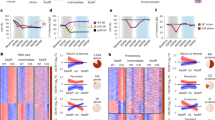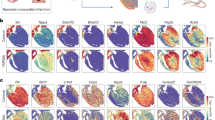Abstract
Cardiogenesis within embryos or associated with heart repair requires stem cell differentiation into energetically competent, contracting cardiomyocytes. While it is widely accepted that the coordination of genetic circuits with developmental bioenergetics is critical to phenotype specification, the metabolic mechanisms that drive cardiac transformation are largely unknown. Here, we aim to define the energetic requirements for and the metabolic microenvironment needed to support the cardiac differentiation of embryonic stem cells. We demonstrate that anaerobic glycolytic metabolism, while sufficient for embryonic stem cell homeostasis, must be transformed into the more efficient mitochondrial oxidative metabolism to secure cardiac specification and excitation–contraction coupling. This energetic switch was programmed by rearrangement of the metabolic transcriptome that encodes components of glycolysis, fatty acid oxidation, the Krebs cycle, and the electron transport chain. Modifying the copy number of regulators of mitochondrial fusion and fission resulted in mitochondrial maturation and network expansion, which in turn provided an energetic continuum to supply nascent sarcomeres. Disrupting respiratory chain function prevented mitochondrial organization and compromised the energetic infrastructure, causing deficient sarcomerogenesis and contractile malfunction. Thus, establishment of the mitochondrial system and engagement of oxidative metabolism are prerequisites for the differentiation of stem cells into a functional cardiac phenotype. Mitochondria-dependent energetic circuits are thus critical regulators of de novo cardiogenesis and targets for heart regeneration.
Key Points
-
While anaerobic metabolism is sufficient to sustain embryonic stem cell energetics, it must be transformed into mitochondria-mediated oxidative metabolism to secure cardiac specification
-
Induction of cardiogenic pathways is linked to restructuring of the metabolic transcriptome and organization of the mitochondrial network
-
Maturation and integration of mitochondria with the nascent electromechanical apparatus confer the functional competence required to develop a cardiac phenotype
-
Disruption of respiratory chain function and prevention of mitochondrial network organization compromise the developing energetic infrastructure, causing deficient sarcomere formation, improper beating area assembly, and defective contractility
-
As mandatory components of genomic reprogramming during cardiac differentiation, energetic circuits are metabolic regulators of cardiogenesis and targets for heart regeneration
This is a preview of subscription content, access via your institution
Access options
Subscribe to this journal
Receive 12 print issues and online access
$209.00 per year
only $17.42 per issue
Buy this article
- Purchase on Springer Link
- Instant access to full article PDF
Prices may be subject to local taxes which are calculated during checkout



Similar content being viewed by others
References
Donovan PJ and Gearhart J (2001) The end of the beginning for pluripotent stem cells. Nature 414: 92–97
Behfar A et al. (2002) Stem cell differentiation requires a paracrine pathway in the heart. FASEB J 16: 1558–1566
Perez-Terzic C et al. (2003) Structural adaptation of the nuclear pore complex in stem cell-derived cardiomyocytes. Circ Res 92: 444–452
Hodgson DM et al. (2004) Stable benefit of embryonic stem cell therapy in myocardial infarction. Am J Physiol 287: H471–H479
Van Laake LW et al. (2005) Cardiomyocytes derived from stem cells. Ann Med 37: 499–512
Lev S et al. (2005) Differentiation pathways in human embryonic stem cell-derived cardiomyocytes. Ann NY Acad Sci 1047: 50–65
Kirby ML (2002) Molecular embryogenesis of the heart. Pediatr Dev Pathol 5: 516–543
Foley A and Mercola M (2004) Heart induction: embryology to cardiomyocyte regeneration. Trends Cardiovasc Med 14: 121–125
Dzeja PP and Terzic A (2003) Phosphotransfer networks and cellular energetics. J Exp Biol 206: 2039–2047
Naya FJ et al. (2002) Mitochondrial deficiency and cardiac sudden death in mice lacking the MEF2A transcription factor. Nat Med 8: 1303–1309
Kelly DP and Scarpulla RC (2004) Transcriptional regulatory circuits controlling mitochondrial biogenesis and function. Genes Dev 18: 357–368
Spitkovsky D et al. (2004) Activity of complex III of the mitochondrial electron transport chain is essential for early heart muscle cell differentiation. FASEB J 18: 1300–1302
St John JC et al. (2005) The expression of mitochondrial DNA transcription factors during early cardiomyocyte in vitro differentiation from human embryonic stem cells. Cloning Stem Cells 7: 141–153
Behfar A et al. (2005) Administration of allogenic stem cells dosed to secure cardiogenesis and sustained infarct repair. Ann NY Acad Sci 1049: 189–198
Menard C et al. (2005) Transplantation of cardiac-committed mouse embryonic stem cells to infarcted sheep myocardium: a preclinical study. Lancet 366: 1005–1012
Yang Y and Balcarcel RR (2004) 96-well plate assay for sublethal metabolic activity. Assay Drug Dev Technol 2: 353–361
Dzeja PP et al. (2002) Energetic communication between mitochondria and nucleus directed by catalyzed phosphotransfer. Proc Natl Acad Sci USA 99: 10156–10161
Perez-Terzic C et al. (2001) Directed inhibition of nuclear import in cellular hypertrophy. J Biol Chem 276: 20566–20571
Sathananthan H et al. (2002) The fine structure of human embryonic stem cells. Reprod Biomed Online 4: 56–61
Sturmey RG and Leese HJ (2003) Energy metabolism in pig oocytes and early embryos. Reproduction 126: 197–204
Singla DK et al. (2006) Transplantation of embryonic stem cells into the infarcted mouse heart: formation of multiple cell types. J Mol Cell Cardiol 40: 195–200
Sathananthan AH and Trounson AO (2000) Mitochondrial morphology during preimplantational human embryogenesis. Hum Reprod 15: 148–159
Goffart S et al. (2004) Regulation of mitochondrial proliferation in the heart: power-plant failure contributes to cardiac failure in hypertrophy. Cardiovasc Res 64: 198–207
Koyanagi M et al. (2005) Cell-to-cell connection of endothelial progenitor cells with cardiac myocytes by nanotubes: a novel mechanism for cell fate changes? Circ Res 96: 1039–1041
Smirnova E et al. (2001) Dynamin-related protein Drp1 is required for mitochondrial division in mammalian cells. Mol Cell Biol 12: 2245–2256
Tondera D et al. (2005) The mitochondrial protein MTP18 contributes to mitochondrial fission in mammalian cells. J Cell Sci 118: 3049–3059
Misaka T et al. (2006) The dynamin-related mouse mitochondrial GTPase OPA1 alters the structure of the mitochondrial inner membrane when exogenously introduced into COS-7 cells. Neurosci Res 55: 123–133
Mukamel Z and Kimchi A (2004) Death-associated protein 3 localizes to the mitochondria and is involved in the process of mitochondrial fragmentation during cell death. J Biol Chem 279: 36732–36738
Chen H and Chan DC (2005) Emerging functions of mammalian mitochondrial fusion and fission. Hum Mol Genet 14: R283–R289
John GB et al. (2005) The mitochondrial inner membrane protein mitofilin controls cristae morphology. Mol Biol Cell 16: 1543–1554
Seyer P et al. (2006) Mitochondrial activity regulates myoblast differentiation by control of c-Myc expression. J Cell Physiol 207: 75–86
Smith J et al. (2000) Redox state is a central modulator of the balance between self-renewal and differentiation in a dividing glial precursor cell. Proc Natl Acad Sci USA 97: 10032–10037
Sauer H et al. (2000) Role of reactive oxygen species and phosphatidylinositol 3-kinase in cardiomyocyte differentiation of embryonic stem cells. FEBS Lett 476: 218–223
Noble M et al. (2005) Redox regulation of precursor cell function: insights and paradoxes. Antioxid Redox Signal 7: 1456–1467
Li J et al. (2006) The NADPH oxidase NOX4 drives cardiac differentiation: Role in regulating cardiac transcription factors and MAP kinase activation. Mol Biol Cell 17: 3978–3988
Lonergan T et al. (2006) Differentiation-related changes in mitochondrial properties as indicators of stem cell competence. J Cell Physiol 208: 149–153
Acknowledgements
This work was supported by the National Institutes of Health (NIH), American Heart Association, Marriott Heart Disease Research Program, Marriott Foundation, Ted Nash Long Life Foundation, Ralph Wilson Medical Research Foundation, Asper Foundation, and the Mayo Clinic Clinician-Investigator Program.
Author information
Authors and Affiliations
Corresponding author
Ethics declarations
Competing interests
The authors declare no competing financial interests.
Rights and permissions
About this article
Cite this article
Chung, S., Dzeja, P., Faustino, R. et al. Mitochondrial oxidative metabolism is required for the cardiac differentiation of stem cells. Nat Rev Cardiol 4 (Suppl 1), S60–S67 (2007). https://doi.org/10.1038/ncpcardio0766
Received:
Accepted:
Issue Date:
DOI: https://doi.org/10.1038/ncpcardio0766
This article is cited by
-
Metabolic switching, growth kinetics and cell yields in the scalable manufacture of stem cell-derived insulin-producing cells
Stem Cell Research & Therapy (2024)
-
TRPA1 promotes the maturation of embryonic stem cell-derived cardiomyocytes by regulating mitochondrial biogenesis and dynamics
Stem Cell Research & Therapy (2023)
-
PARP1 mediated PARylation contributes to myogenic progression and glucocorticoid transcriptional response
Cell Death Discovery (2023)
-
Nanotopography reveals metabolites that maintain the immunomodulatory phenotype of mesenchymal stromal cells
Nature Communications (2023)
-
WD repeat domain 82 (Wdr82) facilitates mouse iPSCs generation by interfering mitochondrial oxidative phosphorylation and glycolysis
Cellular and Molecular Life Sciences (2023)



